Design and Performance Analysis of a Compact Quad-Element UWB MIMO Antenna for Automotive Communications
Abstract
:1. Introduction
2. Antenna Design
2.1. Unit Cell Design
2.2. MIMO Antenna Design
2.3. MIMO Antenna Performance
2.3.1. Envelope Correlation Coefficient (ECC) and Diversity Gain (DG)
2.3.2. Mean Effective Gain (MEG) and Total Active Reflection Coefficient (TARC)
- The majority of papers reported in the literature did not show the MEG value, with the exception of [27], where the MEG value was less than the proposed MIMO antenna.
3. Antenna Housing Effects
4. On-Vehicle Characteristics of the Antenna
5. Conclusions
Author Contributions
Funding
Acknowledgments
Conflicts of Interest
References
- Pell, B.D.; Sulic, E.; Rowe, W.S.T.; Ghorbani, K.; John, S. Advancements in Automotive Antennas; IntechOpen: London, UK, 2011. [Google Scholar] [CrossRef]
- Zuazola, I.J.G.; Elmirghani, J.M.H.; Batchelor, J.C. A Telematics System Using In-Vehicle UWB Communications; IntechOpen: London, UK, 2011. [Google Scholar] [CrossRef] [Green Version]
- Garcia Zuazola, I.; Elmirghani, J.; Batchelor, J. High-speed ultra-wide band in-car wireless channel measurements. Commun. IET 2009, 3, 1115–1123. [Google Scholar] [CrossRef] [Green Version]
- Abdalla, M.A.; Wahba, W.W.; Allam, A.A. Analysis and design of a compact CRLH inspired—Defected ground resonators for triple band antenna applications. Eng. Sci. Technol. Int. J. 2020, 23, 114–122. [Google Scholar] [CrossRef]
- Imran, A.I.; Elwi, T.A. A cylindrical wideband slotted patch antenna loaded with Frequency Selective Surface for MRI applications. Eng. Sci. Technol. Int. J. 2017, 20, 990–996. [Google Scholar] [CrossRef]
- Sharma, M.K.; Kumar, M.; Saini, J.P. Design and Analysis of a Compact UWB-MIMO Antenna with Improved Isolation for UWB/WLAN Applications. Wirel. Pers. Commun. 2021, 1–16. [Google Scholar] [CrossRef]
- Behdad, N.; Li, M.; Yusuf, Y. A Very Low-Profile, Omnidirectional, Ultrawideband Antenna. IEEE Antennas Wirel. Propag. Lett. 2013, 12, 280–283. [Google Scholar] [CrossRef]
- Mao, C.; Chu, Q. Compact Coradiator UWB-MIMO Antenna with Dual Polarization. IEEE Trans. Antennas Propag. 2014, 62, 4474–4480. [Google Scholar] [CrossRef]
- Tang, X.; Yao, Z.; Li, Y.; Zong, W.; Liu, G.; Shan, F. A high performance UWB MIMO antenna with defected ground structure and U-shape branches. Int. J. RF Microw. Comput.-Aided Eng. 2021, 31, e22270. [Google Scholar] [CrossRef]
- Ali, W.A.; Ibrahim, A.A. A Compact Double-Sided MIMO Antenna with an Improved Isolation for UWB Applications. AEU-Int. J. Electron. Commun. 2017, 82, 7–13. [Google Scholar] [CrossRef]
- Altaf, A.; Iqbal, A.; Smida, A.; Smida, J.; Althuwayb, A.A.; Hassan Kiani, S.; Alibakhshikenari, M.; Falcone, F.; Limiti, E. Isolation Improvement in UWB-MIMO Antenna System Using Slotted Stub. Electronics 2020, 9, 1582. [Google Scholar] [CrossRef]
- Liu, X.; Wang, Z.; Yin, Y.; Ren, J.; Wu, J. A Compact Ultrawideband MIMO Antenna Using QSCA for High Isolation. IEEE Antennas Wirel. Propag. Lett. 2014, 13, 1497–1500. [Google Scholar] [CrossRef]
- Srivastava, G.; Mohan, A. Compact MIMO Slot Antenna for UWB Applications. IEEE Antennas Wirel. Propag. Lett. 2016, 15, 1057–1060. [Google Scholar] [CrossRef]
- Sultan, K.S.; Abdullah, H.H. Planar UWB MIMO-Diversity Antenna with Dual Notch Characteristics. Prog. Electromagn. Res. C 2019, 93, 119–129. [Google Scholar] [CrossRef] [Green Version]
- Tripathi, S.; Mohan, A.; Yadav, S. A Compact Koch Fractal UWB MIMO Antenna with WLAN Band-Rejection. IEEE Antennas Wirel. Propag. Lett. 2015, 14, 1565–1568. [Google Scholar] [CrossRef]
- Bilal, M.; Saleem, R.; Abbasi Hammad, H.; Shafique, M.F.; Brown, A.K. An FSS-Based Nonplanar Quad-Element UWB-MIMO Antenna System. Antennas Wirel. Propag. Lett. 2017, 16, 987–990. [Google Scholar] [CrossRef]
- Kumar, J.P.; Karunakar, G. Compact C-shaped MIMO diversity antenna for quad band applications with hexagonal stub for isolation improvement. Int. J. RF Microw. Comput.-Aided Eng. 2019, 29, e21971. [Google Scholar] [CrossRef]
- Pannu, P.; Sharma, D.K. A low-profile quad-port UWB MIMO antenna using defected ground structure with dual notch-band behavior. Int. J. RF Microw. Comput.-Aided Eng. 2020, 30, e22288. [Google Scholar] [CrossRef]
- Srivastava, K.; Kumar, A.; Kanaujia, B.K.; Dwari, S.; Kumar, S. A CPW-fed UWB MIMO antenna with integrated GSM band and dual band notches. Int. J. RF Microw. Comput.-Aided Eng. 2019, 29, e21433. [Google Scholar] [CrossRef] [Green Version]
- Mathur, R.; Dwari, S. Compact CPW-Fed Ultrawideband MIMO Antenna Using Hexagonal Ring Monopole Antenna Elements. AEU-Int. J. Electron. Commun. 2018, 93, 1–6. [Google Scholar] [CrossRef]
- Sipal, D.; Abegaonkar, M.P.; Koul, S.K. Compact planar 2 × 2 and 4 × 4 UWB mimo antenna arrays for portable wireless devices. Microw. Opt. Technol. Lett. 2018, 60, 86–92. [Google Scholar] [CrossRef]
- Saad, A.A.R. Approach for Improving Inter-Element Isolation of Orthogonally Polarised MIMO Slot Antenna over Ultra-Wide Bandwidth. Electron. Lett. 2018, 54, 1062–1064. [Google Scholar] [CrossRef]
- Kumar, R.; Surushe, G. Design of microstrip-fed printed UWB diversity antenna with tee crossed shaped structure. Eng. Sci. Technol. Int. J. 2016, 19, 946–955. [Google Scholar] [CrossRef] [Green Version]
- Naktong, W.; Ruengwaree, A. Four-Port Rectangular Monopole Antenna for UWB-MIMO Applications. Prog. Electromagn. Res. B 2020, 87, 19–38. [Google Scholar] [CrossRef]
- Farahani, M.; Mohammad-Ali-Nezhad, S. A novel UWB printed monopole MIMO antenna with non-uniform transmission line using nonlinear model predictive. Eng. Sci. Technol. Int. J. 2020, 23, 1385–1396. [Google Scholar] [CrossRef]
- Hasan, M.N.; Chu, S.; Bashir, S. A DGS monopole antenna loaded with U-shape stub for UWB MIMO applications. Microw. Opt. Technol. Lett. 2019, 61, 2141–2149. [Google Scholar] [CrossRef]
- Tiwari, R.N.; Singh, P.; Kanaujia, B.K.; Srivastava, K. Neutralization Technique Based Two and Four Port High Isolation MIMO Antennas for UWB Communication. AEU-Int. J. Electron. Commun. 2019, 110, 152828. [Google Scholar] [CrossRef]
- Boologam, A.V.; Krishnan, K.; Palaniswamy, S.K.; Manimegalai, C.T.; Gauni, S. On the Design and Analysis of Compact Super-Wideband Quad Element Chiral MIMO Array for High Data Rate Applications. Electronics 2020, 9, 1995. [Google Scholar] [CrossRef]
- Singhal, S. Four element ultra-wideband fractal multiple-input multiple-output antenna. Microw. Opt. Technol. Lett. 2019, 61, 2811–2818. [Google Scholar] [CrossRef]
- Premalatha, J.; Sheela, D. Compact four-port vertically polarized UWB monopole antenna for MIMO communications. Circuit World 2020, in press. [Google Scholar] [CrossRef]
- Raheja, D.K.; Kanaujia, B.K.; Kumar, S. Compact four-port MIMO antenna on slotted-edge substrate with dual-band rejection characteristics. Int. J. RF Microw. Comput.-Aided Eng. 2019, 29, e21756. [Google Scholar] [CrossRef]
- Sipal, D.; Abegaonkar, M.P.; Koul, S.K. Easily Extendable Compact Planar UWB MIMO Antenna Array. IEEE Antennas Wirel. Propag. Lett. 2017, 16, 2328–2331. [Google Scholar] [CrossRef]
- Bahadori, K.; Rahmat-Samii, Y. A Miniaturized Elliptic-Card UWB Antenna with WLAN Band Rejection for Wireless Communications. IEEE Trans. Antennas Propag. 2007, 55, 3326–3332. [Google Scholar] [CrossRef]
- Chacko, B.P.; Augustin, G.; Denidni, T.A. Uniplanar polarisation diversity antenna for ultra-wideband systems. IET Microw. Antennas Propag. 2013, 7, 851–857. [Google Scholar] [CrossRef]
- Chacko, B.P.; Augustin, G.; Denidni, T.A. Uniplanar Slot Antenna for Ultrawideband Polarization-Diversity Applications. IEEE Antennas Wirel. Propag. Lett. 2013, 12, 88–91. [Google Scholar] [CrossRef]
- Alsath, M.G.N.; Kanagasabai, M. Compact UWB Monopole Antenna for Automotive Communications. IEEE Trans. Antennas Propag. 2015, 63, 4204–4208. [Google Scholar] [CrossRef]
- Ramya; Rao, T.R. Penta-band linear tapered feed planar spiral antenna for vehicular communications. Int. J. Microw. Wirel. Technol. 2017, 9, 1523–1532. [Google Scholar] [CrossRef]
- Bactavatchalame, P.; Rajakani, K. Compact broadband slot-based MIMO antenna array for vehicular environment. Microw. Opt. Technol. Lett. 2020, 62, 2024–2032. [Google Scholar] [CrossRef]
- Madhav, B.T.P.; Anilkumar, T. Design and study of multiband planar wheel-like fractal antenna for vehicular communication applications. Microw. Opt. Technol. Lett. 2018, 60, 1985–1993. [Google Scholar] [CrossRef]
- Ez-Zaki, F.; Belahrach, H.; Ghammaz, A. Broadband microstrip antennas with Cantor set fractal slots for vehicular communications. Int. J. Microw. Wirel. Technol. 2021, 13, 295–308. [Google Scholar] [CrossRef]
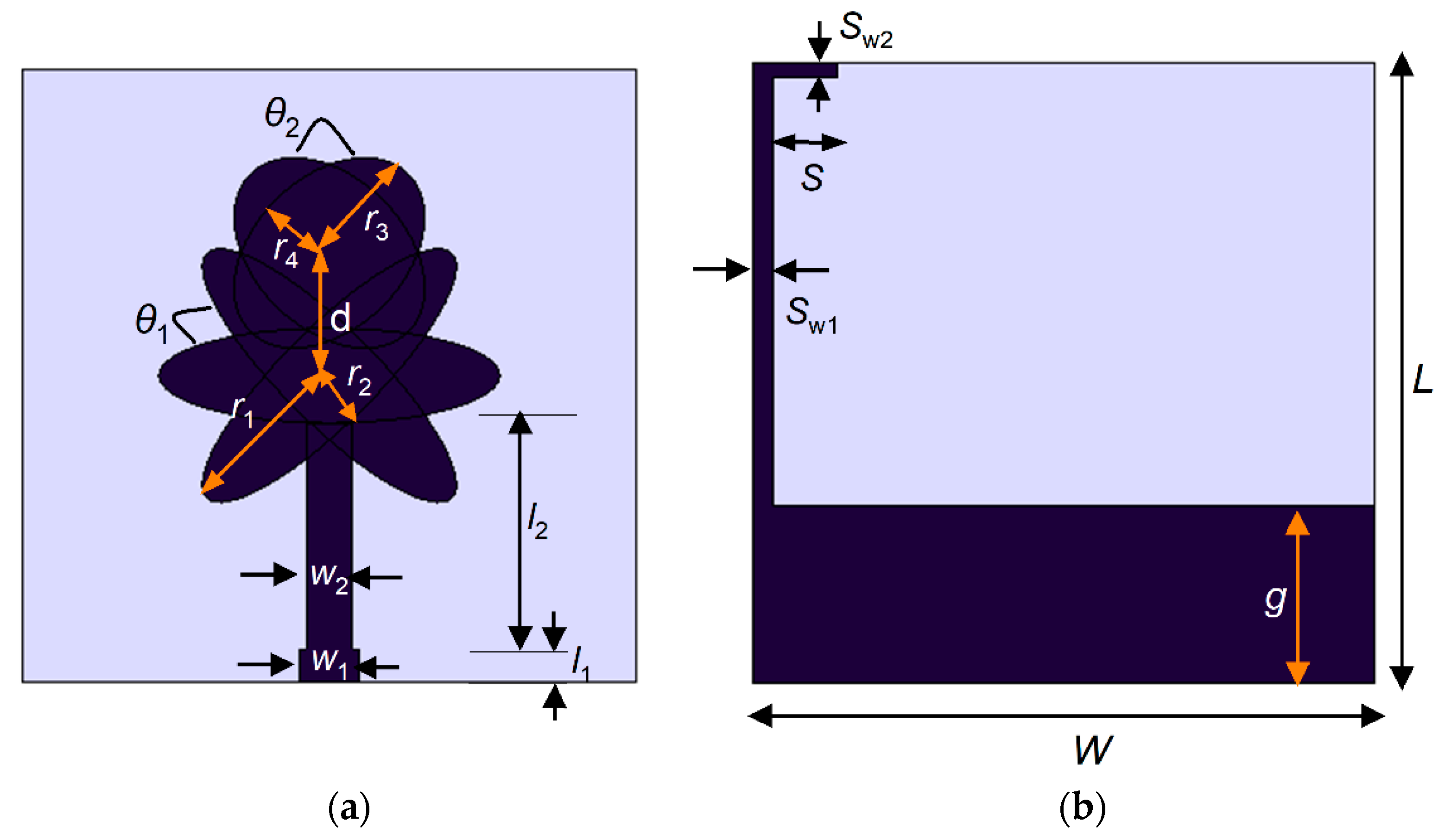


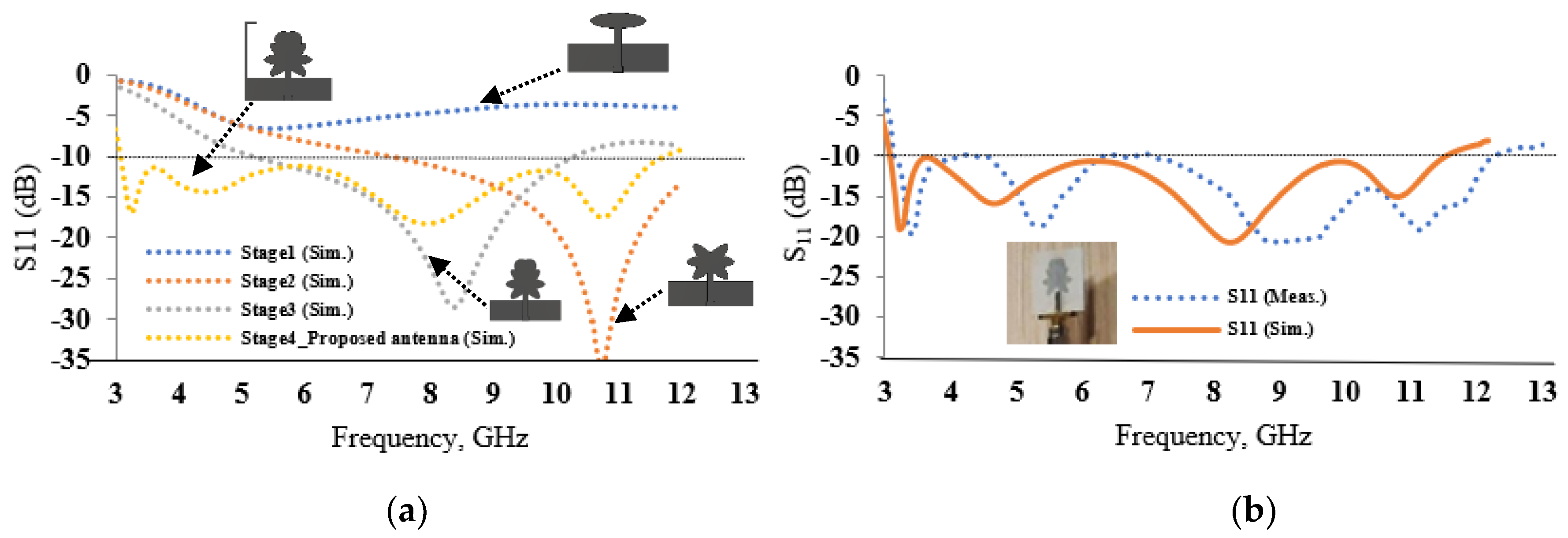

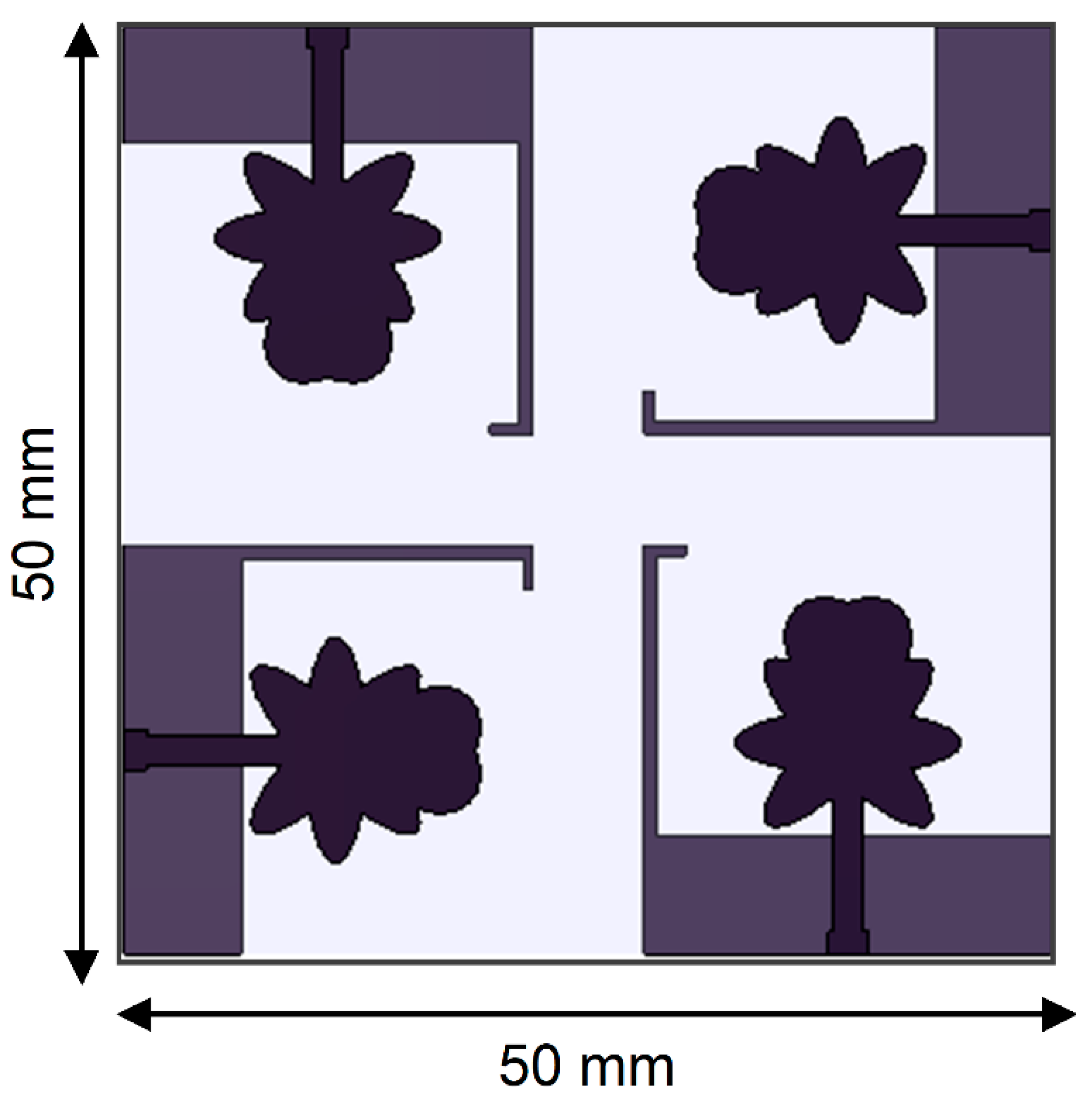
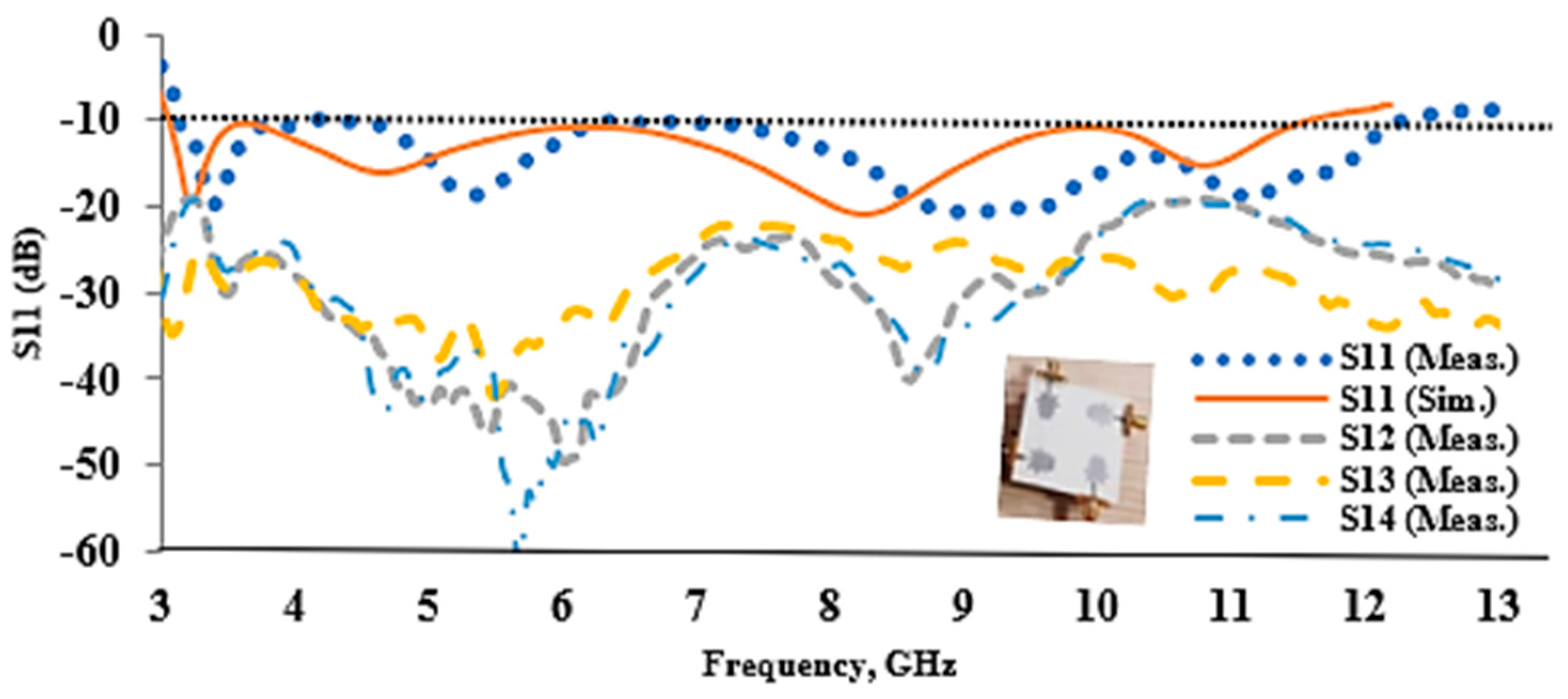


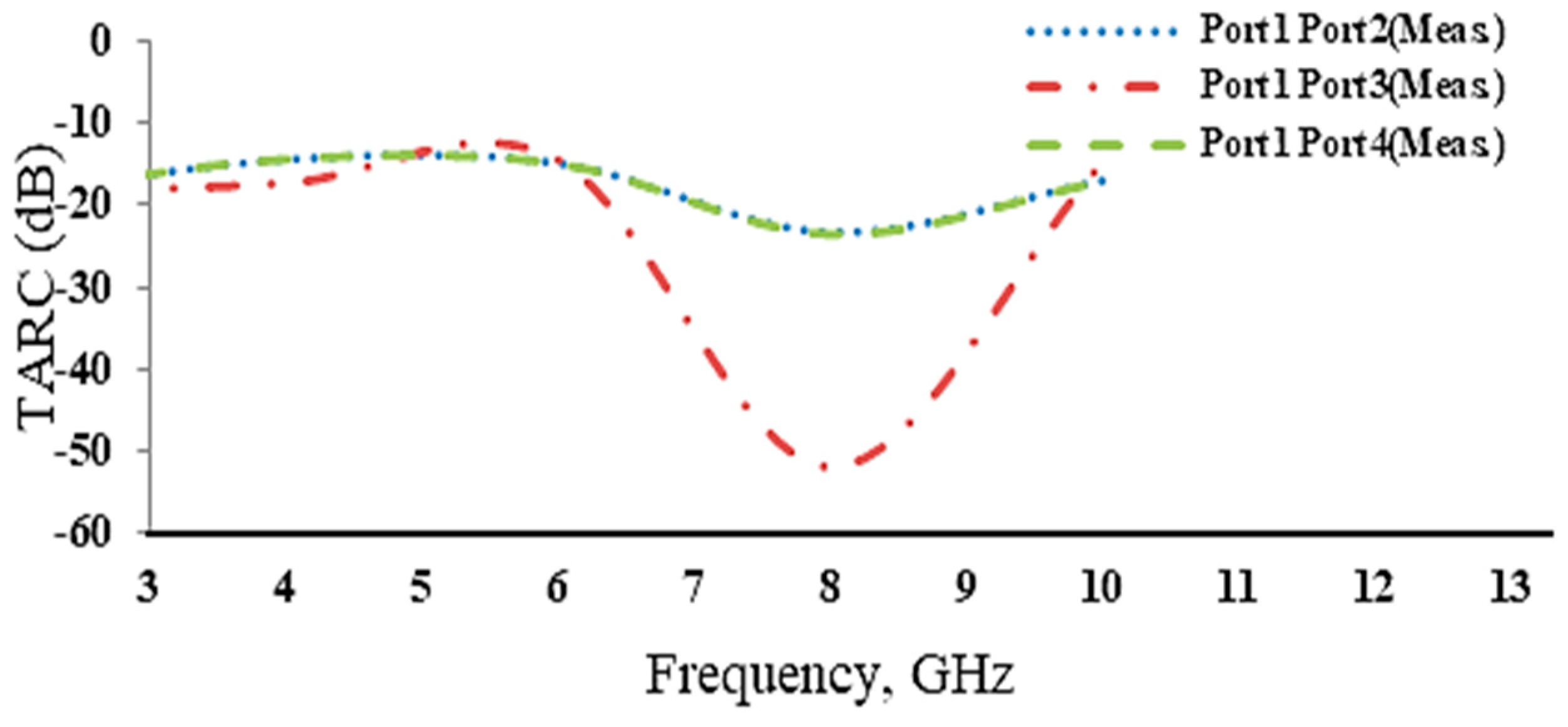



| Frequency (GHz) | ECC (Far-Field) | Isolation (dB) | DG (dB) | TARC (dB) | MEG Ratio |
|---|---|---|---|---|---|
| 4 | 0.0001 | >28.60 | 9.990 | −14.41 | 0.990 |
| 6 | 0.0003 | >33.37 | 9.998 | −14.93 | 0.993 |
| 8 | 0.0002 | >23.49 | 9.998 | −51.90 | 0.998 |
| 10 | 0.0001 | >25.90 | 9.976 | −14.78 | 0.993 |
| Ref. | Antenna Size (mm) | Number of Unit Elements | Impedance Bandwidth (GHz) | Isolation (dB) | ECC | DG (dB) | TARC (dB) | MEG |
|---|---|---|---|---|---|---|---|---|
| [10] | 40 × 40 | 4 | 7.9 | >20 | <0.004 | --- | --- | --- |
| [12] | 60 × 41 | 4 | 8.8 | >20 | <0.25 | --- | --- | --- |
| [14] | 37 × 46 | 4 | 9.5 | >20 | <0.005 | 9.96 | --- | --- |
| [15] | 45 × 45 | 4 | 8.6 | >17 | <0.005 | --- | --- | --- |
| [16] | 32 × 36 | 4 | 7.5 | >20 | <0.002 | --- | --- | --- |
| [18] | 45 × 45 | 4 | 14 | >22 | <0.01 | 10 | <-5 | --- |
| [20] | 47 × 47 | 4 | 9 | >20 | <0.2 | >9.97 | --- | --- |
| [22] | 70 × 70 | 4 | 11.25 | >20 | --- | --- | --- | --- |
| [24] | 80 × 80 | 4 | 8.4 | >17.4 | <0.001 | --- | --- | --- |
| [26] | 80 × 80 | 4 | 8.32 | >15 | <0.015 | >9.90 | --- | --- |
| [27] | 27 × 27 | 4 | 14.6 | >15 | <0.005 | >9.90 | --- | 0.6 |
| [30] | 48 × 34 | 4 | 6.56 | >23 | <0.039 | >9.81 | <−15 | --- |
| [32] | 58 × 58 | 4 | 10.5 | >22 | <0.008 | --- | --- | --- |
| Prop. | 50 × 50 | 4 | 9.1 | >20 | <0.004 | >9.90 | <−14.41 | 0.99 |
Publisher’s Note: MDPI stays neutral with regard to jurisdictional claims in published maps and institutional affiliations. |
© 2021 by the authors. Licensee MDPI, Basel, Switzerland. This article is an open access article distributed under the terms and conditions of the Creative Commons Attribution (CC BY) license (https://creativecommons.org/licenses/by/4.0/).
Share and Cite
Arumugam, S.; Manoharan, S.; Palaniswamy, S.K.; Kumar, S. Design and Performance Analysis of a Compact Quad-Element UWB MIMO Antenna for Automotive Communications. Electronics 2021, 10, 2184. https://doi.org/10.3390/electronics10182184
Arumugam S, Manoharan S, Palaniswamy SK, Kumar S. Design and Performance Analysis of a Compact Quad-Element UWB MIMO Antenna for Automotive Communications. Electronics. 2021; 10(18):2184. https://doi.org/10.3390/electronics10182184
Chicago/Turabian StyleArumugam, Sriram, Sangeetha Manoharan, Sandeep Kumar Palaniswamy, and Sachin Kumar. 2021. "Design and Performance Analysis of a Compact Quad-Element UWB MIMO Antenna for Automotive Communications" Electronics 10, no. 18: 2184. https://doi.org/10.3390/electronics10182184






